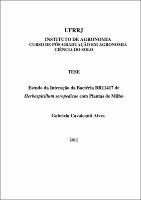Por favor, use este identificador para citar o enlazar este ítem:
http://rima110.im.ufrrj.br:8080/jspui/handle/20.500.14407/11054| metadata.dc.type: | Tese |
| Título : | Estudo da interação da bactéria BR11417 de Herbaspirillum seropedicae com plantas de milho |
| Otros títulos : | Study of interaction of bacterium Herbaspirillum seropedicae BR 11417 with plants of maize |
| metadata.dc.creator: | Alves, Gabriela Cavalcanti |
| metadata.dc.contributor.advisor1: | Reis, Veronica Massena |
| metadata.dc.contributor.advisor-co1: | Araújo, Jean Luiz Simões de |
| metadata.dc.contributor.referee1: | Boddey, Robert Michael |
| metadata.dc.contributor.referee2: | Vidal, Márcia Soares |
| metadata.dc.contributor.referee3: | Roesch, Luiz Fernando Wurdig |
| metadata.dc.description.resumo: | O aproveitamento eficiente do nitrogênio atmosférico é um fator essencial para a agricultura sustentável e para o agronegócio mundial. A utilização de fertilizantes minerais nitrogenados em plantas não-leguminosas constitui um dos maiores custos na agricultura. Além disso, estudos comprovam que o emprego excessivo desses produtos causa danos ao meio ambiente. O objetivo deste estudo foi avaliar as interações entre genótipos de milho x inoculação da bactéria diazotrófica Herbaspirillum seropedicae estirpe BR11417. Foram implantados ensaios em quatro áreas experimentais em diferentes classes de solo e estados do Brasil, nas safras e safrinhas de 3 anos consecutivos. Foi inoculada a estirpe BR11417 nos genótipos de milho híbrido BRS1030 e BRS1010, e variedades BRS4157 e BR106, em experimento fatorial com blocos casualizados. As variáveis analisadas foram produtividade média de grãos, e teor e acúmulo de N. Também foi quantificada a contribuição da FBN pela técnica da abundância natural de 15N em um dos locais. Os resultados dos experimentos foram avaliados de forma conjunta. Para a variável produtividade, os locais de cultivo diferiram, assim como as épocas. Os híbridos foram superiores as variedades e o modelo linear foi o que melhor explicou as médias de produtividade para o fator adubação nitrogenada. A inoculação contribuiu para o aumento do rendimento de grãos na safrinha para o genótipo BRS1030, principalmente quando receberam adubação nitrogenada. Os híbridos também acumularam mais N do que as variedades, mas foi na safrinha onde se observou os maiores teores de N. Foram verificadas diferenças significativas nos d15N para o fator inoculação sendo verificada a contribuição de 26% do N absorvido. |
| Resumen : | The efficient usage of atmospheric nitrogen is an essential factor for sustainable agriculture and the world-wide agribusiness. The mineral nitrogen fertilizers applied in non-leguminous plants constitutes one of the biggest costs of agriculture. Moreover, studies prove that the excessive usage of these products may cause environmental damages. The objective of this study was to evaluate interactions between genotypes of maize vs. inoculation of the diazotrophic bacterium Herbaspirillum seropedicae strain BR11417. The experiments were set in four areas with different soils and states of Brazil, in crops planted in the wet and dry seasons, for three consecutive years. The strain BR11417 was inoculated in genotypes of hybrid maize BRS1030 and BRS1010, and the varieties BRS4157 and BR106, in an experiment with factorial design and randomized blocks. The variables analyzed were grain average productivity, and nitrogen content and accumulation. Also, it was quantified the FBN contribution using the technique of natural abundance of 15N in one of the sites. The results of the experiments were combined to be evaluated. For the variable grain productivity, the production sites differed, as well as the harvest time. The hybrids showed superior results to the varieties, and the linear model better explained the averages of grain productivity for the factor nitrogen fertilization. The inoculation contributed for increasing of grain yield, in the dry season crop, for the genotype BRS1030, mainly when it received nitrogen fertilization. The hybrids also accumulated more N than the varieties, but it was at the dry season when it was observed the highest content of nitrogen. There were detected significant differences in d15N for the factor inoculation, with a contribution of 26% of the absorbed N. |
| Palabras clave : | 15N Fixação biológica de nitrogênio Biological nitrogen fixation |
| metadata.dc.subject.cnpq: | Agronomia |
| metadata.dc.language: | por |
| metadata.dc.publisher.country: | Brasil |
| Editorial : | Universidade Federal Rural do Rio de Janeiro |
| metadata.dc.publisher.initials: | UFRRJ |
| metadata.dc.publisher.department: | Instituto de Agronomia |
| metadata.dc.publisher.program: | Programa de Pós-Graduação em Agronomia - Ciência do Solo |
| Citación : | ALVES, Gabriela Cavalcanti. Estudo da interação da bactéria BR11417 de Herbaspirillum seropedicae com plantas de milho. 2011. 52 f. Tese (Doutorado em Agronomia - Ciência do Solo) - Instituto de Agronomia, Universidade Federal Rural do Rio de Janeiro, Seropédica, 2011. |
| metadata.dc.rights: | Acesso Aberto |
| URI : | https://rima.ufrrj.br/jspui/handle/20.500.14407/11054 |
| Fecha de publicación : | 24-feb-2011 |
| Aparece en las colecciones: | Doutorado em Agronomia - Ciência do Solo |
Se for cadastrado no RIMA, poderá receber informações por email.
Se ainda não tem uma conta, cadastre-se aqui!
Ficheros en este ítem:
| Fichero | Descripción | Tamaño | Formato | |
|---|---|---|---|---|
| 2011 - Gabriela Cavalcanti Alves.pdf | 2011 - Gabriela Cavalcanti Alves | 503.59 kB | Adobe PDF |  Visualizar/Abrir |
Los ítems de DSpace están protegidos por copyright, con todos los derechos reservados, a menos que se indique lo contrario.

